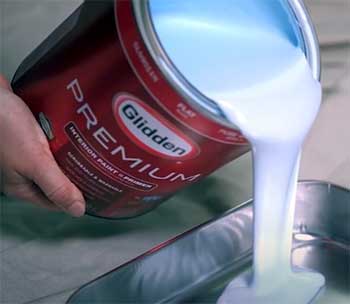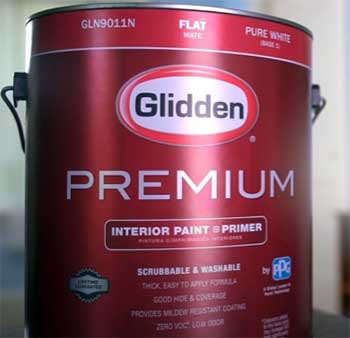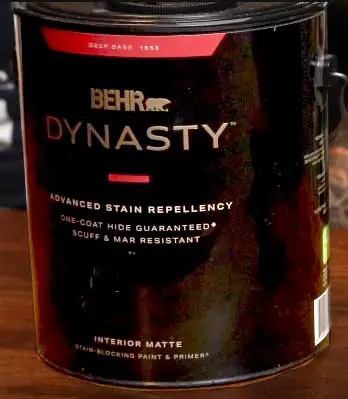I’ve painted enough rooms to know that choosing the right paint can make or break a project. Whether you’re refreshing a bedroom or tackling an exterior overhaul, Glidden and Behr are two brands you’ll likely encounter at Home Depot.
Both have their fans, but which one truly delivers for your needs? In this article, I’ll walk you through my experience with both brands, breaking down their pros and cons, key features, and performance to help you decide.
By the end, you’ll have a clear picture of which paint suits your next project best.
A Brief Comparison Table
| Feature | Glidden | Behr |
| Price (per gallon) | $24–$37 (Diamond) | $34–$70 (Marquee, Dynasty) |
| Coverage | Decent, often needs 2 coats | Excellent, often 1-coat coverage |
| Durability | Moderate, good for low-traffic areas | High, ideal for high-traffic areas |
| Application | Smooth, easy for DIYers | Thicker, trickier for beginners |
| VOC Content | Zero VOC (Diamond) | Low VOC, some zero VOC options |
| Color Options | ~1,200 colors | ~3,000–4,000 colors |
| Availability | Home Depot, Walmart, Amazon | Home Depot only |
| Best For | Budget-conscious projects | Premium quality, durability |
This table sums up the key differences, but let’s get into the details to see how these paints stack up in real-world scenarios.
My Journey with Glidden And Behr
As a homeowner who’s rolled up my sleeves for countless painting projects, I’ve used both Glidden and Behr extensively. From repainting my living room to sprucing up my weathered deck, I’ve seen these brands in action.
Glidden often feels like the budget-friendly friend who gets the job done without fuss, while Behr comes across as the premium choice that demands a bit more skill but delivers a polished result.
Let’s break down what makes each brand tick, starting with their core offerings and how they perform.
Glidden: The Budget-Friendly Workhorse

Glidden, owned by PPG Industries, has been a go-to for cost-conscious homeowners like me.
Its flagship line, Glidden Diamond, is what I reach for when I want solid performance without breaking the bank.
Priced between $24 and $37 per gallon, it’s significantly cheaper than Behr’s top-tier options.
I’ve used Glidden Diamond for interior walls, and its zero-VOC formula means I don’t have to worry about lingering odors in my home—perfect when you’ve got kids or pets.
Pros of Glidden
- Affordability: At roughly half the price of Behr’s premium lines, Glidden is a lifesaver for large projects. When I painted my entire basement, the savings added up fast.
- Ease of Application: Glidden’s consistency is smooth and forgiving. Even on days when my painting skills were rusty, it went on evenly with minimal effort.
- Zero VOC Options: The Diamond line’s zero-VOC formula is a big win for indoor projects. I painted my daughter’s bedroom and had no headaches or fumes to deal with.
- Wide Availability: You can grab Glidden at Home Depot, Walmart, or even Amazon. This flexibility is great when you’re in a pinch and need paint fast.
- Quick Drying: Glidden dries fast—often within an hour. This saved me time when I was rushing to finish a guest room before visitors arrived.
Cons of Glidden
- Coverage Limitations: Glidden often requires two coats, especially with darker colors. I learned this the hard way when painting over a bold red accent wall—my arm was sore from the extra rolling.
- Moderate Durability: While decent, Glidden doesn’t hold up as well in high-traffic areas. My hallway painted with Glidden Diamond showed scuffs after a year of kids running through.
- Limited Color Range: With around 1,200 colors, Glidden’s palette is solid but pales compared to Behr’s. I struggled to find the exact shade of teal I wanted for my bathroom.
- Not Ideal for Exterior Extremes: Glidden’s exterior paints are weather-resistant, but I noticed some fading on my fence after two Michigan winters.
Glidden’s strength lies in its balance of cost and quality. It’s my pick when I’m tackling a low-stakes project or need to cover a large area on a tight budget. But for spaces that need to withstand daily wear or bold color precision, I’ve found it can fall short.
Behr: The Premium Powerhouse

Behr, sold exclusively at Home Depot, is the brand I turn to when I want a professional-grade finish. Its top lines—Marquee, Dynasty, and Premium Plus—are pricier, ranging from $34 to $70 per gallon, but they deliver where it counts.
I used Behr Marquee for my kitchen, and the one-coat coverage over a dark green wall was a game-changer. Behr’s paints often include primer, which cuts down on prep time, and their durability makes them a favorite for high-traffic areas.
Pros of Behr
- Superior Coverage: Behr’s Marquee and Dynasty lines often cover in one coat, even over dark colors. This saved me hours when repainting my dining room.
- High Durability: Behr stands up to wear and tear. My kitchen walls, painted three years ago, still look fresh despite constant cleaning and kids’ fingerprints.
- Extensive Color Palette: With 3,000–4,000 colors, Behr has a shade for every vision. I found the perfect sage green for my office after browsing their endless options.
- Weather Resistance: Behr’s exterior paints are built for tough conditions. My deck, coated with Behr Premium Plus, has held up through rain, snow, and sun without peeling.
- Mildew and Mold Resistance: Behr’s paints are formulated to resist mildew, which was a lifesaver for my humid basement.
Cons of Behr
- Higher Cost: At $60–$70 for Marquee or Dynasty, Behr can strain your wallet. I felt the pinch when painting my entire exterior.
- Thicker Consistency: Behr’s thick texture can be tricky for beginners. I had to practice my roller technique to avoid streaks in my living room.
- Moderate Drying Time: Behr takes longer to dry—up to four hours in some cases. This slowed me down when I was eager to finish a project in a weekend.
- Limited Availability: You’re stuck shopping at Home Depot. When I needed a quick touch-up and wasn’t near one, I was out of luck.
- Slight Odor: While low-VOC, Behr’s paints have a stronger smell than Glidden’s zero-VOC options. I noticed this when painting my enclosed porch.
Behr is my go-to when I want a premium look and long-lasting results, especially for exterior projects or rooms that take a beating. But the price and application challenges mean it’s not always the practical choice for every job.
Key Features of Glidden Paint And Behr Face-Off
Let’s get into the specifics of what sets these brands apart. I’ve broken down the key features based on my hands-on experience and what I’ve learned from other painters.
- Price and Value

Glidden is the clear winner for budget shoppers.
A gallon of Glidden Diamond costs $24–$37, making it ideal for large projects like my basement overhaul.
Behr’s premium lines, like Marquee, can hit $70 per gallon, which adds up fast.
However, Behr’s one-coat coverage often means you use less paint overall, so the value evens out for smaller, high-impact projects.
For example, I spent more on Behr for my kitchen but saved on labor and time.
- Coverage and Coats
Behr takes the crown here. Its Marquee and Dynasty lines consistently cover in one coat, even over bold colors like the navy blue in my son’s bedroom. Glidden Diamond, while decent, often needs two coats, especially for darker shades.
When I painted over a burgundy accent wall, Glidden required a second coat and extra primer, which was a hassle.
- Durability and Longevity
Behr’s durability is unmatched for high-traffic areas. My hallway, painted with Behr Premium Plus, has endured years of kids, pets, and moving furniture without a scratch.
Glidden Diamond is solid for low-traffic spaces like bedrooms, but I noticed scuffs and fading in my entryway after a year. For exterior projects, Behr’s weather resistance shines—my fence painted with Behr has held its color through two harsh winters, while Glidden’s exterior paint on my shed showed slight peeling.
- Application and Ease of Use
Glidden is a dream for DIYers like me. Its smooth, fluid consistency makes it easy to roll or brush without streaks. I painted my guest room in a day with no issues. Behr, on the other hand, has a thicker texture that requires more skill.
When I used Behr Marquee on my dining room walls, I had to work carefully to avoid lap marks, especially since it dries faster than I expected.
- Color Selection
Behr’s massive color range—3,000–4,000 shades—gives you endless options. I spent hours picking the perfect charcoal gray for my office, and Behr’s color-matching tech nailed it.
Glidden’s 1,200 colors are respectable, but I’ve occasionally struggled to find unique hues. Both brands offer color-matching, but Behr’s broader palette makes it easier to get an exact match for custom projects.
- VOC Content and Odor
Glidden Diamond’s zero-VOC formula is a standout for indoor painting. I used it in my daughter’s nursery and didn’t have to air out the room for days. Behr’s paints are low-VOC, with some zero-VOC options, but I’ve noticed a slight chemical smell when using Marquee indoors.
For sensitive spaces, Glidden has the edge.
- Availability
Glidden’s availability at Home Depot, Walmart, and Amazon is a major plus. I’ve ordered it online for quick delivery when I didn’t feel like driving. Behr’s exclusivity to Home Depot is convenient if you’re nearby, but it’s a pain if you’re not.
I once had to delay a project because my local Home Depot was out of the specific Behr shade I needed.
Real-World Scenarios: Which Paint For Which Project?
To help you choose, here are some scenarios based on my experience:

- Interior Low-Traffic Areas (e.g., Bedrooms): Glidden Diamond is my pick. Its affordability and easy application make it perfect for spaces that don’t see much wear. I painted my guest bedroom with Glidden and got a smooth, professional finish for half the cost of Behr.
- High-Traffic Areas (e.g., Kitchens, Hallways): Behr Marquee or Premium Plus is the way to go. The durability and one-coat coverage are worth the extra cost. My kitchen walls still look pristine after three years of heavy use.
- Exterior Projects: Behr’s weather resistance makes it my top choice for decks, fences, or siding. My deck painted with Behr Premium Plus has withstood Michigan’s brutal winters without fading. Glidden works for less exposed surfaces like sheds but may not hold up as well.
- Budget-Conscious Large Projects: Glidden is the better bet. When I painted my 1,500-square-foot basement, Glidden’s low price and decent coverage kept costs down without sacrificing too much quality.
- Specialty Surfaces (e.g., Brick or Concrete): Glidden’s Premium line outperforms Behr on brick and concrete. I used Glidden on my patio, and it adhered beautifully, while Behr felt too thick for the job.
My Personal Take: Balancing Quality And Cost
After years of painting, I’ve learned that neither brand is universally “better.” Glidden is my go-to when I’m pinching pennies or working on a low-stakes project. Its ease of use and affordability make it a no-brainer for quick touch-ups or large surfaces.
Behr, though, is my choice when I want a premium finish that lasts. The upfront cost stings, but the time saved on coats and the long-term durability make it worthwhile for key areas of my home.
One thing I’ve noticed is that prep work matters just as much as the paint itself. No matter how great Behr’s Marquee is, it won’t look good if you skip priming or skimp on surface cleaning. Similarly, Glidden can shine with proper prep, even on trickier surfaces.
I always use a high-quality brush and roller—Purdy is my favorite—to get the best results from either brand.
Tips For Getting The Most Out of Glidden and Behr
Here are some lessons I’ve picked up to maximize your painting experience:

- Test Colors First: Both brands offer sample sizes. I always paint a small patch and check it under different lighting before committing. Colors can look wildly different on your wall versus the swatch.
- Invest in Good Tools: A $15 brush and $5 roller make a huge difference. I learned this after a streaky disaster with a cheap roller and Glidden.
- Prime When Needed: Behr’s paint-and-primer combos are great, but for bold color changes, I still use a separate primer. Glidden always needs one for dark or uneven surfaces.
- Check Sales: Home Depot often runs deals on both brands. I snagged Glidden Diamond for $20 a gallon during a holiday sale, and Behr’s Premium Plus was discounted during a spring promo.
- Stir Well: Behr’s thick consistency needs thorough stirring. I made the mistake of skipping this once and ended up with uneven color.
Frequently Asked Questions (FAQ)
Glidden is more affordable and easier to apply, ideal for budget projects or low-traffic areas, but often requires two coats. Behr offers superior coverage and durability, perfect for high-traffic spaces or exterior projects, but it’s pricier and trickier to apply.
Yes, Glidden is a quality paint, especially its Diamond line, offering good coverage and zero VOCs at a budget-friendly price. However, it’s less durable than premium brands like Behr for high-traffic or exterior use.
Many professional painters use Behr, particularly its Marquee and Dynasty lines, for their excellent coverage and durability. It’s a favorite for projects where clients want long-lasting, high-quality results.
Sherwin-Williams and Benjamin Moore are comparable to Behr in terms of quality, coverage, and durability. Glidden and Valspar are more affordable alternatives but may not match Behr’s premium performance.
Wrapping It Up: Your Paint, Your Choice
Choosing between Glidden and Behr comes down to your project’s needs and your budget. If you’re looking to save money and still get a decent finish, Glidden’s affordability and ease of use make it a solid pick.
If you want a premium, long-lasting result that can handle wear and tear, Behr’s quality is worth the investment. I’ve used both to transform my home, and each has its place depending on the job.
Take a moment to assess your priorities—cost, durability, or ease—and you’ll find the perfect paint to bring your vision to life.
